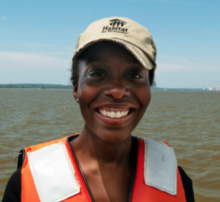Eight students will be presenting the summer work at the Ocean Sciences Meeting in March 2022!
Alina Martinez, University of the District of Columbia
Class Year:
2019Mentor:
Jian Zhao, Ph.D.Project Title:
Anticyclonic Eddies and Their Influences on Temperature and Salinity in the Mid-Atlantic BightAbstract:
Eddies are large, circular, temporary currents that trap water and marine life in their center and carry them far away from their origin (Chelton et. al 2011). The Gulf Stream in the North Atlantic Ocean sheds eddies of two different types: anticyclonic (clockwise rotating) eddies to its north and west, and cyclonic (counterclockwise rotating) eddies to its south and east (https://marine.coastal.edu/gulfstream/p6.htm). When anticyclonic eddies impinge upon the shelf break in the Mid Atlantic Bight, they quickly dissipate, and the material that was trapped in their center is released and dispersed (Zhang and Gawarkiewicz 2015).
Until recently, little was known about the extent of water exchange between the shallow shelf water in the Mid Atlantic Bight, which is a relatively cold, fresh, nutrient dense water mass, and warm, salty, nutrient poor water from the deep ocean released when anticyclonic eddies impinge upon the shelf break (Zhang and Gawarkiewicz 2015). This study sought to explore the relationship between anticyclonic eddies (also called warm core rings) that impinge upon the continental shelf and salinity variability within the shelf.
Upon analysis, it was revealed that there is a moderate correlation between the number of anticyclonic eddies that impinge upon the shelf per year and salinity changes along the continental shelf. Further analysis revealed that there is an even stronger correlation between eddy numbers weighted by amplitude and salinity. The strongest correlation was established between eddy numbers weighted by radius and salinity.
Presentations:
Martinez, A.*, J. Zhao, and L. Sanford. 2020. Anticyclonic Eddies and their Influences on Salinity in the Mid-Atlantic Bight. Ocean Sciences Meeting, San Diego, CA.







































